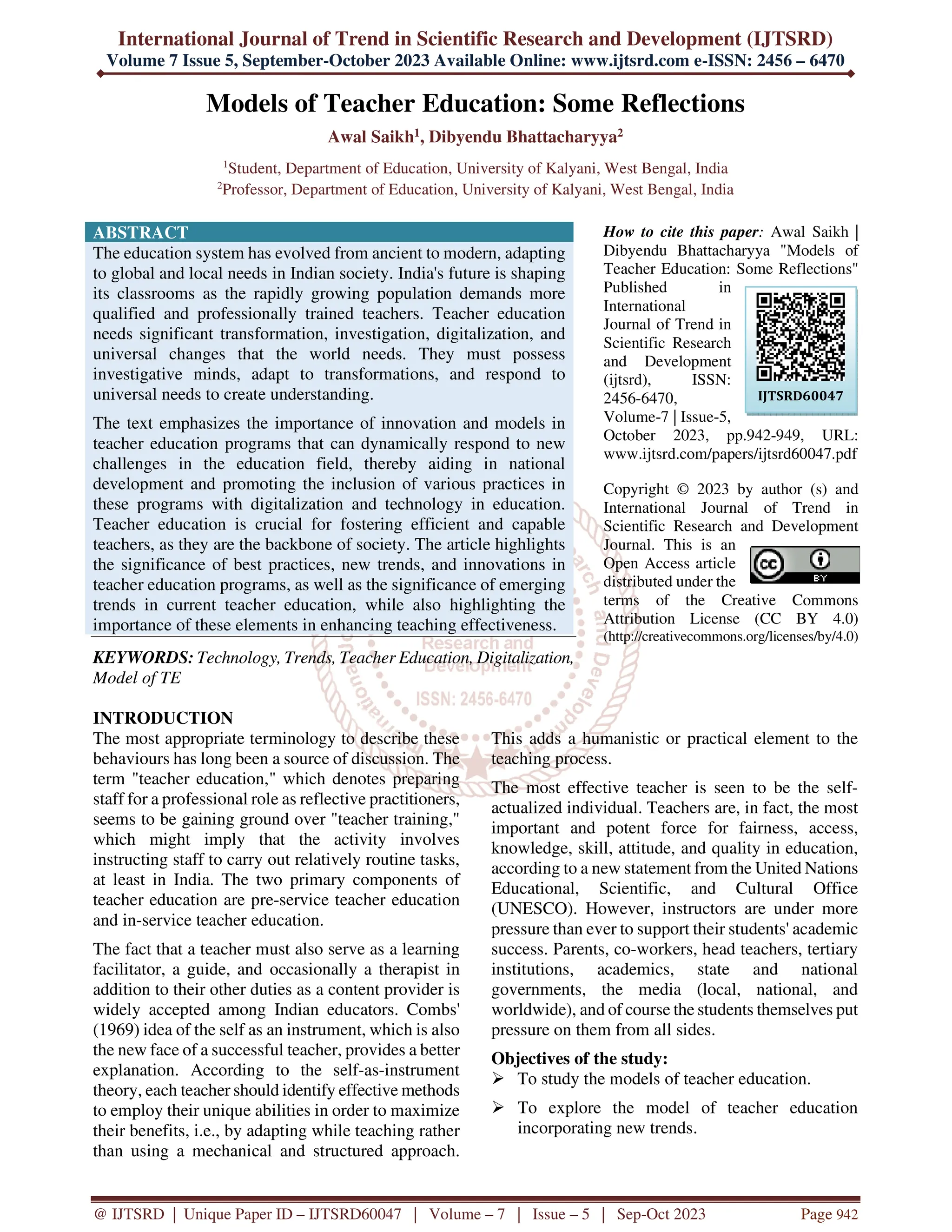The article discusses the evolution and importance of teacher education in India, emphasizing the need for transformation and innovation to meet modern educational demands. It highlights the significance of integrating digitalization and new pedagogical models to enhance teacher effectiveness and respond to national development needs. Additionally, the text explores various educational models and trends, including competency-based and inquiry-oriented approaches, advocating for a research-based foundation in teacher education.






![International Journal of Trend in Scientific Research and Development @ www.ijtsrd.com eISSN: 2456-6470
@ IJTSRD | Unique Paper ID – IJTSRD60047 | Volume – 7 | Issue – 5 | Sep-Oct 2023 Page 948
Conclusion:
In actuality, teachers who are reflective practitioners
have certain traits with passive technicians, whereas
teachers who are transformational intellectuals
skillfully share traits. I utilize them to better show the
link between these teacher education models and
teacher duties in our education system. The function
of the teacher as a transformational intellectual shows
a smaller figure: the teacher as a reflective
practitioner who developed confidence. That indicates
that these roles are not mutually exclusive but rather
complimentary, and that teachers must possess the
traits of all of these roles in order to fulfill their actual
missions. This could only be done by using a more
thorough and critical approach to teacher education. If
the classroom culture is positive, we can bring
authentic learning into the classroom, give our
students more opportunities, and enable them to
positively connect with not only the subject matter
but also with their peers and teachers. Teachers are
responsible for setting the tone and mood of the
classroom. Teacher education is becoming more and
more of a global service, and it needs high standards
in the country. Curricula must be skillfully,
knowledgably, and thoroughly developed so that
teachers may use a variety of innovative teaching
techniques and digitalization to meet the unique
requirements of their pupils. It is really time to keep
up with the trends and adapt the technology for the
teacher education model.
References:
[1] Albert, R. S., Runco, M. A. (1999). A history of
research on creativity. In Handbook of
creativity (Vol. 2, pp. 16-31).
[2] Ayeni, M. A., & Adeleye, J. O. (2014). Teacher
Education and Social Ethics. International
Journal of Education and Literacy Studies, 2(2):
1–3. https://doi.org/10.7575/aiac.ijels.v.2n.2p.1.
[3] Barker, R.L., 1975, Implementing
performance/competency based Teacher
Education, p.23, Journal of Industrial Teacher
Education, Vol. 12, No. 4.
[4] Bolitho, R and Padwad, A. (Eds.) 2011.
Continuing professional development lessons
from India. New Delhi: British Council.
[5] Cochran-Smith, M. (2005). Teacher education
and the outcomes trap. Journal of Teacher
Education, 56(5), 411–417. Darling-Hammond,
L., & Bransford, J. (Eds.). (2005).
[6] Darling-Hammond, Linda, and Milbrey W.
McLaughlin. “Policies that Support
Professional Development in an Era of
Reform.” Phi Delta Kappan, vol. 76, no. 8,
1995, pp. 597-604.
[7] Donna J. Cole (1984) Multicultural education
and global education: A possible merger,
Theory Into Practice, 23:2, 151-154,
DOI:10.1080/00405848409543106.
[8] Elliott, J. & Adelman, C. circa 1975, Classroom
Action Research, pp.22-23. Ford Teaching
Project. Also M.D. Gall, 1970, The Use of
Questions in Teaching, pp.7O7- 721, Reviews
of Educational Research, Vol. 40 (s).
[9] Ganeles, D., 1974, Competence-Based
Preparation Pro- • gramme for Teachers of
Adults, ps. 187-189, Adult Leadership, Vol. 20,
No. 6.
[10] Hertzberg, H.W., 1976, Competency Based
Teacher Education: Does it have a Past' or
Future? P.13, Teachers College Record, Vol.
78, No. 1.
[11] Houston, W.R. & Brown, K.W., 1975, op.cit.
p.7.
[12] http://downloads.ncss.org/NCSSTeacherStanda
rdsVol1-rev2004.pdf www.ijcrt.org © 2022
IJCRT | Volume 10, Issue 5 May 2022 | ISSN:
2320-2882 IJCRT2205049 International
Journal of Creative Research Thoughts (IJCRT)
www.ijcrt.org a443.
[13] https://www.academia.edu/22885838/Innovativ
e_Practices_in_Teacher_Education retrievedon
2 march 22.
[14] Iredale, R. (1996). The significance of teacher
education for international education
development: Global perspectives on teacher
education, C. Brock (Ed.). Oxfordshire:
Triangle Books, pp. 9-18.
[15] Jadhav, V. (2011). “ICT and Teacher
Education”. International Educational E-
Journal (Quarterly), 1(1):39–58.
http://faculty.ksu.edu.sa/Alhassan/2503/ICT
and teacher education in Australia 2003.pdf.
[16] Lahiri, S. (2017). “Education for sustainable
Development in Teacher Education in India”.
ZEP: Zeitschrift Für Internationale Bildungs
forschung Und Entwicklungspädagogik, 40(3):
30–36.
[17] May, J., Rama, D., Sabasales, M., Antonio, A.,
& Ricohermoso, C. (2020). “Virtual Teaching
as the ’ New Norm ‘: Analyzing Science
Teachers ’ Attitude toward Online Teaching ,
Technological Competence and Access,](https://image.slidesharecdn.com/130modelsofteachereducationsomereflections-231229122005-d5afb20a/75/Models-of-Teacher-Education-Some-Reflections-7-2048.jpg)
![International Journal of Trend in Scientific Research and Development @ www.ijtsrd.com eISSN: 2456-6470
@ IJTSRD | Unique Paper ID – IJTSRD60047 | Volume – 7 | Issue – 5 | Sep-Oct 2023 Page 949
Technological Com. July.
https://doi.org/10.2139/ssrn.3654236.
[18] Mardiana, H. (2020). “Lecturers ’ Attitudes
towards Online Teaching in the Learning
Process”. Register Journal 13(1): 77–98.
[19] National Board for Professional Teaching
Standards. (1989). What teachers should know
and be able to do. Retrieved Feb 26,2022.
[20] Naaz, I. (2020). Comparison of Student
Teachers’ Perception of Institutional Climate in
Government and Private Teacher Education
Institutions. Our Heritage; UGC CARE listed
Journal, Vol. 68(48): 223-233.
[21] Preparing teachers for a changing world: What
teachers should learn and be able to do. San
Francisco: Jossey-Bass. Darling-Hammond, L.,
& Hammerness, K. (2005).
[22] The design of teacher education programs. In L.
Darling-Hammond & J. Bransford (Eds.),
Preparing teachers for a changing world: What
teachers should learn and be able to do (pp.
390–441).
[23] Schmieder, A.A., 1975, Ten Critical Issues in
Educational Reform, p.18. Journal of Teacher
Education, Vol. 26, No. 1.
[24] Shaw, K.E., 1976, Paradigms or Contested
Concepts, p.22, British Journal of Educational
Technology, Vol. 7, No. 2.](https://image.slidesharecdn.com/130modelsofteachereducationsomereflections-231229122005-d5afb20a/75/Models-of-Teacher-Education-Some-Reflections-8-2048.jpg)